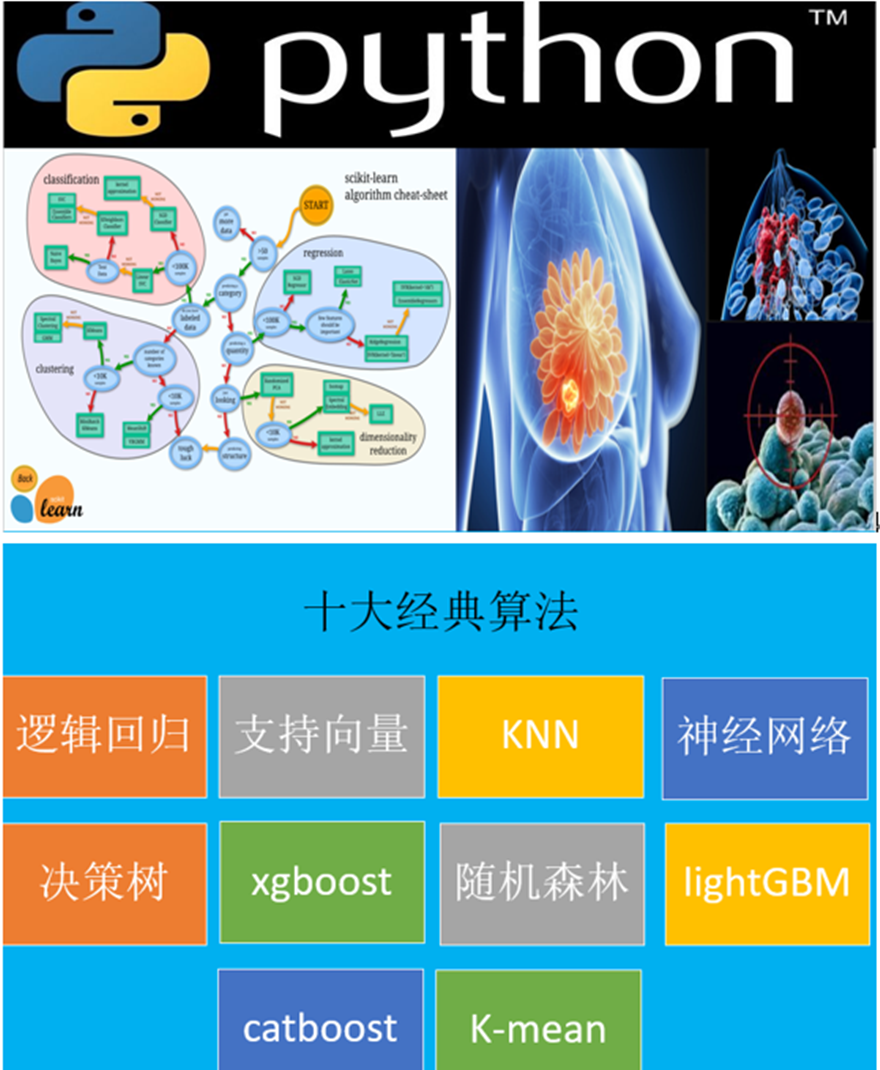数据预处理:独热编码(One-Hot Encoding)
python机器学习-sklearn挖掘乳腺癌细胞( 博主亲自录制,包含独热编码(One-Hot Encoding)代码)
网易云观看地址

问题由来
在很多机器学习任务中,特征并不总是连续值,而有可能是分类值。
例如,考虑一下的三个特征:
["male", "female"]
["from Europe", "from US", "from Asia"]
["uses Firefox", "uses Chrome", "uses Safari", "uses Internet Explorer"]
如果将上述特征用数字表示,效率会高很多。例如:
["male", "from US", "uses Internet Explorer"] 表示为[0, 1, 3]
["female", "from Asia", "uses Chrome"]表示为[1, 2, 1]
但是,即使转化为数字表示后,上述数据也不能直接用在我们的分类器中。因为,分类器往往默认数据数据是连续的(可以计算距离?),并且是有序的(而上面这个0并不是说比1要高级)。但是,按照我们上述的表示,数字并不是有序的,而是随机分配的。
独热编码
为了解决上述问题,其中一种可能的解决方法是采用独热编码(One-Hot Encoding)。独热编码即 One-Hot 编码,又称一位有效编码,其方法是使用N位状态寄存器来对N个状态进行编码,每个状态都由他独立的寄存器位,并且在任意时候,其中只有一位有效。
例如:
自然状态码为:000,001,010,011,100,101
独热编码为:000001,000010,000100,001000,010000,100000
可以这样理解,对于每一个特征,如果它有m个可能值,那么经过独热编码后,就变成了m个二元特征(如成绩这个特征有好,中,差变成one-hot就是100, 010, 001)。并且,这些特征互斥,每次只有一个激活。因此,数据会变成稀疏的。
这样做的好处主要有:
解决了分类器不好处理属性数据的问题
在一定程度上也起到了扩充特征的作用
举例
基于Scikit-learn的例子:
from sklearn import preprocessing
enc = preprocessing.OneHotEncoder()
enc.fit([[0, 0, 3], [1, 1, 0], [0, 2, 1], [1, 0, 2]])
enc.transform([[0, 1, 3]]).toarray()
输出结果:
array([[ 1., 0., 0., 1., 0., 0., 0., 0., 1.]])
Note: fit了4个数据3个特征,而transform了1个数据3个特征。第一个特征两种值(0: 10, 1: 01),第二个特征三种值(0: 100, 1: 010, 2: 001),第三个特征四种值(0: 1000, 1: 0100, 2: 0010, 3: 0001)。所以转换[0, 1, 3]为[ 1., 0., 0., 1., 0., 0., 0., 0., 1.]。
处理离散型特征和连续型特征并存的情况,如何做归一化?
连续型特征归一化[数据标准化/归一化normalization]
1、离散型特征的处理方法:
a) Binarize categorical/discrete features: For all categorical features, represent them as multiple boolean features. For example, instead of having one feature called marriage_status, have 3 boolean features - married_status_single, married_status_married, married_status_divorced and appropriately set these features to 1 or -1. As you can see, for every categorical feature, you are adding k binary feature where k is the number of values that the categorical feature takes.对于离散的特征基本就是按照one-hot编码,该离散特征有多少取值,就用多少维来表示该特征。
为什么使用one-hot编码来处理离散型特征?
1、Why do we binarize categorical features?
We binarize the categorical input so that they can be thought of as a vector from the Euclidean space (we call this as embedding the vector in the Euclidean space).使用one-hot编码,将离散特征的取值扩展到了欧式空间,离散特征的某个取值就对应欧式空间的某个点。
2、Why do we embed the feature vectors in the Euclidean space?
Because many algorithms for classification/regression/clustering etc. requires computing distances between features or similarities between features. And many definitions of distances and similarities are defined over features in Euclidean space. So, we would like our features to lie in the Euclidean space as well.将离散特征通过one-hot编码映射到欧式空间,是因为,在回归,分类,聚类等机器学习算法中,特征之间距离的计算或相似度的计算是非常重要的,而我们常用的距离或相似度的计算都是在欧式空间的相似度计算,计算余弦相似性,基于的就是欧式空间。
3、Why does embedding the feature vector in Euclidean space require us to binarize categorical features?
Let us take an example of a dataset with just one feature (say job_type as per your example) and let us say it takes three values 1,2,3.
Now, let us take three feature vectors x_1 = (1), x_2 = (2), x_3 = (3). What is the euclidean distance between x_1 and x_2, x_2 and x_3 & x_1 and x_3? d(x_1, x_2) = 1, d(x_2, x_3) = 1, d(x_1, x_3) = 2. This shows that distance between job type 1 and job type 2 is smaller than job type 1 and job type 3. Does this make sense? Can we even rationally define a proper distance between different job types? In many cases of categorical features, we can properly define distance between different values that the categorical feature takes. In such cases, isn't it fair to assume that all categorical features are equally far away from each other?
Now, let us see what happens when we binary the same feature vectors. Then, x_1 = (1, 0, 0), x_2 = (0, 1, 0), x_3 = (0, 0, 1). Now, what are the distances between them? They are sqrt(2). So, essentially, when we binarize the input, we implicitly state that all values of the categorical features are equally away from each other.
将离散型特征使用one-hot编码,确实会让特征之间的距离计算更加合理。比如,有一个离散型特征,代表工作类型,该离散型特征,共有三个取值,不使用one-hot编码,其表示分别是x_1 = (1), x_2 = (2), x_3 = (3)。两个工作之间的距离是,(x_1, x_2) = 1, d(x_2, x_3) = 1, d(x_1, x_3) = 2。那么x_1和x_3工作之间就越不相似吗?显然这样的表示,计算出来的特征的距离是不合理。那如果使用one-hot编码,则得到x_1 = (1, 0, 0), x_2 = (0, 1, 0), x_3 = (0, 0, 1),那么两个工作之间的距离就都是sqrt(2).即每两个工作之间的距离是一样的,显得更合理。
4、About the original question?
Note that our reason for why binarize the categorical features is independent of the number of the values the categorical features take, so yes, even if the categorical feature takes 1000 values, we still would prefer to do binarization.
5、Are there cases when we can avoid doing binarization?没必要用one-hot 编码的情形
Yes. As we figured out earlier, the reason we binarize is because we want some meaningful distance relationship between the different values. As long as there is some meaningful distance relationship, we can avoid binarizing the categorical feature. For example, if you are building a classifier to classify a webpage as important entity page (a page important to a particular entity) or not and let us say that you have the rank of the webpage in the search result for that entity as a feature, then 1] note that the rank feature is categorical, 2] rank 1 and rank 2 are clearly closer to each other than rank 1 and rank 3, so the rank feature defines a meaningful distance relationship and so, in this case, we don't have to binarize the categorical rank feature.
More generally, if you can cluster the categorical values into disjoint subsets such that the subsets have meaningful distance relationship amongst them, then you don't have binarize fully, instead you can split them only over these clusters. For example, if there is a categorical feature with 1000 values, but you can split these 1000 values into 2 groups of 400 and 600 (say) and within each group, the values have meaningful distance relationship, then instead of fully binarizing, you can just add 2 features, one for each cluster and that should be fine.
将离散型特征进行one-hot编码的作用,是为了让距离计算更合理,但如果特征是离散的,并且不用one-hot编码就可以很合理的计算出距离,那么就没必要进行one-hot编码,比如,该离散特征共有1000个取值,我们分成两组,分别是400和600,两个小组之间的距离有合适的定义,组内的距离也有合适的定义,那就没必要用one-hot 编码。
离散特征进行one-hot编码后,编码后的特征,其实每一维度的特征都可以看做是连续的特征。就可以跟对连续型特征的归一化方法一样,对每一维特征进行归一化。比如归一化到[-1,1]或归一化到均值为0,方差为1。
有些情况不需要进行特征的归一化:
It depends on your ML algorithms, some methods requires almost no efforts to normalize features or handle both continuous and discrete features, like tree based methods: c4.5, Cart, random Forrest, bagging or boosting. But most of parametric models (generalized linear models, neural network, SVM,etc) or methods using distance metrics (KNN, kernels, etc) will require careful work to achieve good results. Standard approaches including binary all features, 0 mean unit variance all continuous features, etc。
基于树的方法是不需要进行特征的归一化,例如随机森林,bagging 和 boosting等。基于参数的模型或基于距离的模型,都是要进行特征的归一化。
[What are good ways to handle discrete and continuous inputs together?]
one-hot编码为什么可以解决类别型数据的离散值问题
首先,one-hot编码是N位状态寄存器为N个状态进行编码的方式
eg:高、中、低不可分,→ 用0 0 0 三位编码之后变得可分了,并且成为互相独立的事件
→ 类似 SVM中,原本线性不可分的特征,经过project之后到高维之后变得可分了
GBDT处理高维稀疏矩阵的时候效果并不好,即使是低维的稀疏矩阵也未必比SVM好
Tree Model不太需要one-hot编码
对于决策树来说,one-hot的本质是增加树的深度
tree-model是在动态的过程中生成类似 One-Hot + Feature Crossing 的机制
1. 一个特征或者多个特征最终转换成一个叶子节点作为编码 ,one-hot可以理解成三个独立事件
2. 决策树是没有特征大小的概念的,只有特征处于他分布的哪一部分的概念
one-hot可以解决线性可分问题 但是比不上label econding
one-hot降维后的缺点:
降维前可以交叉的降维后可能变得不能交叉
树模型的训练过程:
从根节点到叶子节点整条路中有多少个节点相当于交叉了多少次,所以树的模型是自行交叉
eg:是否是长的 { 否(是→ 柚子,否 → 苹果) ,是 → 香蕉 } 园 cross 黄 → 形状 (圆,长) 颜色 (黄,红) one-hot度为4的样本
使用树模型的叶子节点作为特征集交叉结果可以减少不必要的特征交叉的操作 或者减少维度和degree候选集
eg 2 degree → 8的特征向量 树 → 3个叶子节点
树模型:Ont-Hot + 高degree笛卡尔积 + lasso 要消耗更少的计算量和计算资源
这就是为什么树模型之后可以stack线性模型
n*m的输入样本 → 决策树训练之后可以知道在哪一个叶子节点上 → 输出叶子节点的index → 变成一个n*1的矩阵 → one-hot编码 → 可以得到一个n*o的矩阵(o是叶子节点的个数) → 训练一个线性模型
典型的使用: GBDT + RF
优点 : 节省做特征交叉的时间和空间
如果只使用one-hot训练模型,特征之间是独立的
对于现有模型的理解:(G(l(张量))):
其中:l(·)为节点的模型
G(·)为节点的拓扑方式
神经网络:l(·)取逻辑回归模型
G(·)取全连接的方式
决策树: l(·)取LR
G(·)取树形链接方式
创新点: l(·)取 NB,SVM 单层NN ,等
G(·)取怎样的信息传递方式
onehot编码实现
onehot = (np.arange(num_labels) == labels[:, None]).astype(np.float32)
from sklearn import preprocessing
enc = preprocessing.OneHotEncoder(sparse=False)
onehot = enc.fit_transform(nominal.values)
https://study.163.com/provider/400000000398149/index.htm?share=2&shareId=400000000398149( 欢迎关注博主主页,学习python视频资源,还有大量免费python经典文章)

扫二维码,关注博主主页,学习更多Python知识

数据预处理:独热编码(One-Hot Encoding)的更多相关文章
- 【转】数据预处理之独热编码(One-Hot Encoding)
原文链接:http://blog.csdn.net/dulingtingzi/article/details/51374487 问题由来 在很多机器学习任务中,特征并不总是连续值,而有可能是分类值. ...
- 机器学习实战:数据预处理之独热编码(One-Hot Encoding)
问题由来 在很多机器学习任务中,特征并不总是连续值,而有可能是分类值. 例如,考虑一下的三个特征: ["male", "female"] ["from ...
- 数据预处理:独热编码(One-Hot Encoding)和 LabelEncoder标签编码
一.问题由来 在很多机器学习任务中,特征并不总是连续值,而有可能是分类值. 离散特征的编码分为两种情况: 1.离散特征的取值之间没有大小的意义,比如color:[red,blue],那么就使用one- ...
- 数据预处理之独热编码(One-Hot Encoding)(转载)
问题由来 在很多机器学习任务中,特征并不总是连续值,而有可能是分类值. 例如,考虑一下的三个特征: ["male", "female"] ["from ...
- 机器学习 数据预处理之独热编码(One-Hot Encoding)
问题由来 在很多机器学习任务中,特征并不总是连续值,而有可能是分类值. 例如,考虑一下的三个特征: ["male", "female"] ["from ...
- 数据预处理之独热编码(One-Hot Encoding)
问题的由来 在很多机器学习任务中,特征并不总是连续值,而有可能是分类值. 例如,考虑以下三个特征: ["male","female"] ["from ...
- OneHotEncoder独热编码和 LabelEncoder标签编码
学习sklearn和kagggle时遇到的问题,什么是独热编码?为什么要用独热编码?什么情况下可以用独热编码?以及和其他几种编码方式的区别. 首先了解机器学习中的特征类别:连续型特征和离散型特征 拿到 ...
- Scikit-learn库中的数据预处理:独热编码(二)
在上一篇博客中介绍了数值型数据的预处理但是真实世界的数据集通常都含有分类型变量(categorical value)的特征.当我们讨论分类型数据时,我们不区分其取值是否有序.比如T恤尺寸是有序的,因为 ...
- 数据预处理之独热编码(One-Hot):为什么要使用one-hot编码?
一.问题由来 最近在做ctr预估的实验时,还没思考过为何数据处理的时候要先进行one-hot编码,于是整理学习如下: 在很多机器学习任务如ctr预估任务中,特征不全是连续值,而有可能是分类值.如下: ...
随机推荐
- linux 安装Brew
点击查看原文 Linuxbrew:Linux下的Homebrew amendgit 关注 2017.02.16 17:20* 字数 455 阅读 4745评论 0喜欢 2 前不久还在跟同事抱怨ubun ...
- Spring MVC 使用介绍(三)—— Controller接口控制器
一.概述 Controller接口类图如下,其中,BaseCommandController已从Spring 4移除 基于继承Controller接口的方式已经不推荐使用,仅供学习参考 二.基于Con ...
- 最简单的Spring Security配置示例
代码结构: pom.xml <?xml version="1.0" encoding="UTF-8"?> <project xmlns=&qu ...
- BZOJ1412[ZJOI2009]狼和羊的故事——最小割
题目描述 “狼爱上羊啊爱的疯狂,谁让他们真爱了一场:狼爱上羊啊并不荒唐,他们说有爱就有方向......” Orez听到这首歌,心想:狼和羊如此和谐,为什么不尝试羊狼合养呢?说干就干! Orez的羊狼圈 ...
- jsp小测试--猜大小
page1.jpg: <%@ page language="java" import="java.util.*" pageEncoding="g ...
- Shell 对整个文件夹中的文件进行MD5校验 [转]
查看本地文件的 MD5 命令:md5sum FileName查看home目录下所有文件的 MD5 码:cd ~find /home -type f -print0 | xargs -0 md5sum ...
- Hdoj 1905.Pseudoprime numbers 题解
Problem Description Fermat's theorem states that for any prime number p and for any integer a > 1 ...
- luogu5007 DDOSvoid 的疑惑 (树形dp)
我们来算每个点出现在的集合的个数 设f[i]为i出现的集合个数,g[i]是只选子树i 可以有多少种选法 那就有$g[i]=1+\prod\limits_{j是i的孩子}{g[j]} , f[i]=f[ ...
- 使用zabbix监控mariadb性能状态
0x01 前言 zabbix内置Mysql的监控模版,因为mariadb和Mysql两者的相关性,所以这个模版也能用在mariadb services上. 0x02 Mysql 首先要在mariadb ...
- N球M盒
N球,M盒,由于球是否相同,盒是否相同,盒是否可以为空,共2^3=8种: 1.球同,盒同,盒不可以为空Pm(N)--这符号表示部分数为m的N-分拆的个数,m是P的下标,为了好看我将大写的M弄成小写 2 ...
